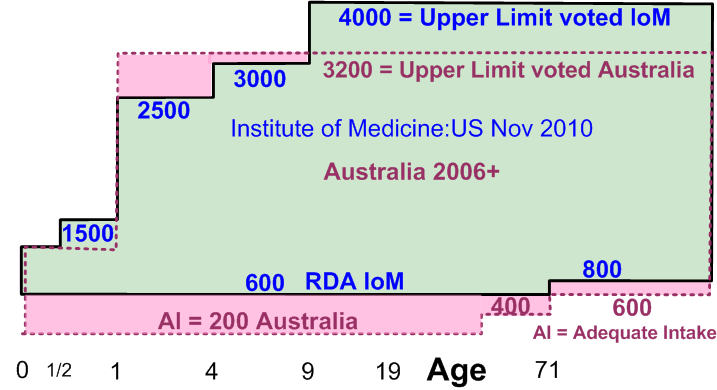Black Sudanese children 350X more likely to have rickets than other Australians
Highlights
75% of rickets cases were those were refugee children,
63 % were born in Africa
47% Sudanese.
85 %were dark-skinned,
13 % categorised as intermediate
2 % were fair skinned
mothers who were veiled for cultural and religious reasons, contributed to low vitamin D levels
Incidence of vitamin D deficiency rickets among Australian children: an Australian Paediatric Surveillance Unit study
Craig F Munns craigm2@chw.edu.au , Peter J Simm, Christine P Rodda, Sarah P Garnett, Margaret R Zacharin, Leanne M Ward, Janet Geddes, Sarah Cherian, Yvonne Zurynski and Christopher T Cowell, on behalf of the APSU Vitamin D Study Group
Med J Aust 2012; 196 (7): 466-468.
Objective: To determine the incidence of and factors associated with vitamin D deficiency rickets in Australian children.
Design: 18-month questionnaire-based prospective observational study, using Australian Paediatric Surveillance Unit (APSU) data.
Setting: Australian paediatricians and child health workers, January 2006 – July 2007.
Participants: Children aged ? 15 years with vitamin D deficiency rickets (25-hydroxyvitamin D [25OHD] ? 50 nmol/L, and elevated alkaline phosphatase levels [> 229 IU/L] and/or radiological rickets).
Main outcome measures: Incidence of vitamin D deficiency rickets. Description of demographics, clinical presentation, identification and further analysis of overrepresented groups, and treatment regimens compared with best-practice guidelines.
Results: We identified 398 children with vitamin D deficiency (55% male; median age, 6.3 years [range, 0.2–15 years]).
The overall incidence in children ? 15 years of age in Australia was 4.9/100 000/year. All had a low 25OHD level (median, 28 nmol/L [range, 5–50 nmol]) and an elevated alkaline phosphatase level (median, 407 IU/L [range, 229–5443 IU/L]), and 48 (12%) were hypocalcaemic.
Ninety-five children had wrist x-rays, of whom 67 (71%) had rachitic changes.
Most (98%) had dark or intermediate skin colour and 18% of girls were partially or completely veiled.
Most children were born in Africa (252; 63%) and 75% of children were refugees.
Duration of exclusive breastfeeding was inversely related to serum vitamin D levels in children < 3 years of age.
Empirical vitamin D treatment was given to 4% of children before diagnosis.
Conclusions: Vitamin D deficiency rickets is a significant problem in Australia among known high-risk groups. Public health campaigns to prevent, identify and treat vitamin D deficiency, especially in high-risk groups, are essential.
Image from PDF attached at the bottom of this page

See also VitaminDWiki
Africa category listing has items along with related searches
Rickets in Denmark especially among immigrant children- Feb 2012
Rickets in 30 % of infants in India who had low vitamin D – March 2011
Vitamin D Levels in Kids are So Low that Rickets is Back with a Vengeance - by Knox
Somali did not have a word for autism before getting to Canada Vitamin D Council 2010
Death of Babies in UK due to vitamin D deficiency – Jan 2012
Vitamin D insufficiency in UK youths – 37X more likely if dark skin – July 2011
Striking ethnic health disparity – blacks dying due to lack of vitamin D – Nov 2011
Turkey gave 400 IU vitamin D to needy infants and reduced Rickets by 60X - 2011
Giving vitamin D to ALL children and pregnant women reduced symptoms by 60 percent – Aug 2012
- Seems like Australia could eliminate a huge cost of rickets by giving 400 IU of vitamin D to all the dark skinned children
- However, the Australian govt still says just 200 IU is enough thru middle age,
- which is probably not enough to stop rickets (see Turkey, above)

